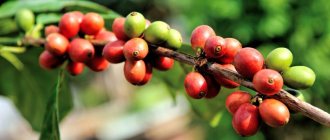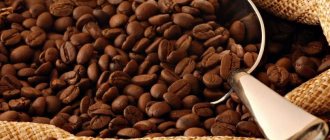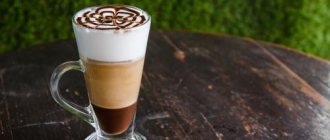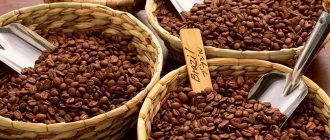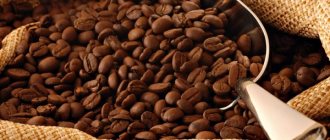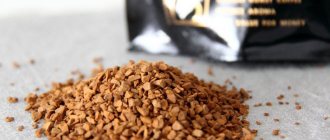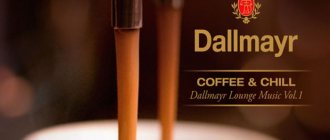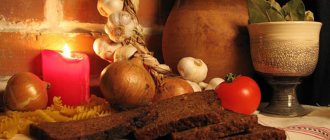Even the most avid coffee lover would hardly be able to list all the varieties of coffee. There are many varieties of coffee beans and drinks based on them. New recipes are constantly being invented. Only by understanding all this abundance will you be able to choose products in accordance with personal preferences and decide on your favorite drinks.
The world's main suppliers of coffee products
In 2020, more than 130 million bags of coffee (60 kg each) were harvested in 50 coffee-producing countries. The main suppliers of products were the following countries (million bags):
- Brazil (35.5);
- Vietnam (27.9);
- Colombia (13.5);
- Indonesia (8.3);
- Honduras (7.1).
Brazil is the main supplier of coffee.
Ethiopia is among the world's top ten largest exporters, with a market share of 4% (up to 4 million bags).
Most of the Arabica coffee here grows in the wild. The most elite varieties of coffee are Sidamo, Harar and Yirgacheffe.
Varieties of coffee beans
It is almost impossible to list all existing varieties of coffee. It will be enough to familiarize yourself with the most popular ones:
- Arabica with its pleasant sour taste is part of any coffee blend.
- Bitter robusta is not used in its pure form - the beans are added to coffee mixtures to make the drink stronger.
- Liberica is a rare African variety with a pungent and bitter taste.
- Excelsa has an original taste and a bright, rich aroma.
Every connoisseur can distinguish these types by taste.
Coffee classification
Coffee is classified by type of tree, type and hardness of beans, processing method, country of origin, degree of roasting. Marks that indicate these parameters are always placed on product packaging.
By type of coffee tree
There are the following main types of coffee trees:
- Arabica. Its homeland is Ethiopia. Trees with red or red-violet fruits grow up to 5 m. Highlands (900-2100 m above sea level) are suitable for plantations. The light brown grains are shaped like an oval, up to 1.5 cm long. Arabica does not tolerate cold well and is susceptible to disease.
- Robusta. Congolese coffee can be distinguished from Arabica coffee by photographs. Trees that reach 10 m in height are grown at altitudes of up to 900 m. The beans are round in shape with a dark red shell.
- Liberica. On tall trees (up to 20 m), oval fruits up to 2.5 cm long appear. Due to its weak taste, it is not of great industrial value.
Arabica is the most popular type of coffee.
Arabica has a sweetish taste. Robusta is characterized by bitterness due to its high caffeine content (2.7%).
By type of coffee beans
There are large, medium, and small grains in size, but different countries have their own labeling. Indonesian manufacturers use the letters L, M, S. In Africa they mark AAA (large), AA (medium), AB (small). Depending on the hardness of the grains, the following markings are accepted:
- SHB - Arabica of the highest degree of hardness, growing at an altitude of 1400 m above sea level;
- HB - hard grains from plantations at an altitude of 1200-1400 m;
- MHB - fruits with medium hardness, growing on the plain;
- LGA is a soft bean used for low-quality coffee.
Elite Arabica coffee has the highest hardness.
According to the method of processing coffee beans
After harvesting, the fruits are subjected to dry or wet processing. In the first case, the grains are washed and left to dry for 3 weeks. They are then peeled and winnowed to remove any remaining skin. Wet processing involves placing the grains in water for 24 hours. Primary fermentation of the fruits occurs, so they become softer. After washing, the grains are cleaned using machines.
Coffee beans vary in how they are processed.
By grain quality
Labeling varies from region to region. The letters A, B, C are often used, which correspond to high, medium and low quality. Some manufacturers have the following designation:
- AA - the best variety;
- AB - good;
- BA - average quality coffee;
- BB is a low quality product.
EP (European preparation) means that up to 8 defects have been removed from 300 g of coffee.
AP (American) involves removing up to 23 defects from a similar quantity of goods.
By degree of freshness
There are 2 types of coffee beans. New crop means packaging immediately after harvesting and processing, old crop means last year's harvest. The mature label is placed on coffee that has been stored in a warehouse for 1 to 3 years. For more mature varieties (6-10 years), the designation vintage/aged coffee is used.
Coffee beans can be from last year's harvest or fresh.
By strength
The strength is influenced by the variety, grinding, roasting and brewing method. The following types of strong coffee are distinguished depending on the caffeine concentration (mg/ml):
- espresso - 2;
- in Turkish - 0.8;
- filter coffee - 0.6;
- Americano, cappuccino - 0.4.
Sometimes the strongest is called ristretto - black coffee prepared in a coffee machine.
This drink has a richer taste due to the presence of essential oils, but contains less caffeine than espresso.
By degree of roasting
Depending on the intensity of heat treatment, there are the following degrees of roasting:
- Easy. The process lasts until the first click. The grains become dry and acquire a light brown color.
- Average. The beans turn out darker.
- Strong. The grains become dark brown and caramelize.
- Highest degree. The fruits are glossy due to the essential oil and acquire a black-brown color.
The grains have different intensities of heat treatment.
Light processing is suitable for high-mountain varieties with a loose structure. Strong coffee is used to make coffee from Cuba, Guatemala, and Africa.
By country of production
South American varieties have a mild flavor with medium intensity. Grains from Ethiopia, Burundi, Zambia, and Uganda are famous for their strength. Congo grows Robusta with a tart flavor, while Kenyan Arabica has a mild aftertaste.
There are classical Arabica plantations in Yemen. Robusta with a pronounced sweet aroma is common in Vietnam.
Classification by place of cultivation of raw materials and production of finished products
Coffee trees grow in approximately 80 countries around the world, 50 of which export beans. To simplify the classification, experts divide coffee into groups, depending on the country in which they were grown:
- South America. This is where the largest number of coffee trees grow. For example, Brazil is considered one of the largest suppliers of grains on the world market. Mostly the varieties are hybrid, but Arabica beans of good quality are also found. Colombia grows exclusively Arabica beans with a soft, rich flavor. Ecuador and Peru are countries where high-quality single-origin coffees are grown. Venezuela, Chile, and Paraguay are also known for their coffee plantations.
Some gourmets believe that South American coffee does not have a very expressive taste.
- Central America. Mexican varieties have a slightly rough taste, so they are often used in mixtures, but in Cuba, Costa Rica, and Guatemala, coffee trees grow, the fruits of which produce a rich, aromatic drink.
- Africa. Ethiopia produces coffee with authentic, natural flavors. Kenya grows smooth, light-tasting Arabica beans, while Uganda is famous for beans with a rich, rich finish.
- Asia, Oceania. In Yemen, Indonesia, Java, and India, excellent single varieties are grown, which are distinguished by their unique, rich taste.
If the trees grew in the mountains, the package is marked SHG, in the foothills - HG, on the plain - CS, MG.
Countries in which coffee plantations are located are often only exporters of the beans. Global companies that produce finished products deserve special attention. Large companies cooperate with global suppliers of raw materials, and thanks to modern innovations they offer consumers a wide range of high-quality coffee.
One of the most expensive and unusual varieties is Luwak coffee. The grains for its production are first fermented in the intestinal tract of animals
Read more in this article: The most expensive and unusual Luwak coffee
Which countries produce finished products?
Types of popular Italian coffee:
- Costadoro;
- Danesi;
- Diemme;
- Illy;
- Lavazza;
- Klimbo.
Coffee in Spain is not just a strong, invigorating drink, but a real tradition. They drink it morning, noon and evening, enjoying every sip. Types of Spanish coffee:
- Torrefacto;
- El Abra;
- Cornella;
- Valienti;
- Oquendo.
Coffee in Greece is loved and enjoyed at any time, hot or cold, often with famous local desserts.
Famous brands of Greek coffee:
- Lumidis;
- Nektar;
- Dandali;
- BRAVO;
- Artius.
In Russia, the well-known company from St. Petersburg “Orimi Trade” is the official representative of the Swiss plant Jardin Cafe Solution SA. It uses world experience and modern technologies to produce high-quality coffee products. The entire range is made from 100% Arabica coffee, without dyes or preservatives.
Rating of coffee producers
The list of the largest producers of beans and ground coffee includes the following companies:
- Lavazza.
- Paulig.
- Kimbo.
- Malongo.
Lavazza is an Italian coffee company.
Jardin coffee is popular. The company sources Arabica from Kenya, Ethiopia, Indonesia, Colombia, and Guatemala.
The best coffees
South America, Ethiopia and Yemen are considered to be the producers of the best products. Most plantations are located at an altitude of 1000 m above sea level, so the grains receive an unusual taste and rich aroma.
Brazilian Bourbon Santos
It received its name in honor of the island of the same name in the Caribbean Sea. For him, the first 3 crops are collected from the trees. The coffee turns out buttery and sour. The drink has a rich taste with a nutty-chocolate aroma and notes of orange.
Brazilian Bourbon Santos is one of the best coffees.
Maragogyp
A distinctive feature is large grains, which are 3.5 times larger than standard Arabica. This drink has a complex taste: spicy with an admixture of wood, wild berries, nougat, and flowers. There is always sourness, the aroma includes tobacco notes.
Medellin
The Colombian variety grows at an altitude of 1800 m above sea level. The beans are lightly roasted to preserve the soft wine-fruit sourness with a caramel aftertaste. The description of the smell is dominated by a light nutty aroma.
Medellin - Colombian coffee of the highest quality.
Colombia Excelso
Coffee plantations are located at an altitude of 900-1800 m in the Cordillera mountains. Columbia Excelso beans are medium in size, have a dense structure with light fruity sourness and sweetness. The aroma includes citrus or nutty notes.
Maracaibo
The photo of this Venezuelan variety shows the main difference from other types - yellow grains. Maracaibo, with a slight taste of dry white wine, grows in the states of Trujillo, Tachira, and Merida. The low quality of the raw materials is compensated by the grape aroma.
Maracaibo is one of the highest quality and delicious varieties of coffee.
Costa Rica
This coffee is considered elite. It has a spicy aroma and high strength. It has a multifaceted taste: cocoa is combined with fruit, vanilla, and honey notes.
Decaf
Decaffeinated coffee is made by treating green beans with solvent, steam, activated carbon or liquid carbon dioxide. This drink is more sour and soft compared to the others. In Russia, decaf has blue or green packaging, while abroad it is orange.
Decaf is produced by extracting caffeine from coffee beans.
Supremo
For this type of coffee, the highest quality beans with a length of more than 7 mm are selected. The variety is grown on the northern slopes of the Cordillera in Colombia. There is almost no acid in it, but the chocolate tastes good. The aftertaste contains apple and almond notes.
Dalat
This Arabica variety grows in the central part of Vietnam at an altitude of 1400-1600 m above sea level. Dalat is a strong coffee with fruity, caramel, and nutty undertones. The aroma includes notes of rosehip, lemongrass, and orange.
Dalat is a Vietnamese Arabica from a highland plantation.
Altura
Coffee beans are grown in the Sierra Maestra region of Cuba at an altitude of 600-800 m. The variety has little acid, but is strong. The drink is famous for its bitterness, which is combined with a tobacco flavor. The aroma is sweet, tart with an almond-caramel undertone.
Antigua
Elite coffee from Guatemala has a dense texture with slight sourness and sweetness. When characterizing Antigua, attention is paid to the thick, spicy aroma with notes of smoke. The drink smells of cocoa, prunes, and fruit.
Antigua is an unusual spicy coffee.
Oksaka
The plantations are located in the southern states of Mexico. The Oksaka variety is distinguished by its light consistency, slight bitterness, and delicate aroma. Depending on the degree of roasting, the flavors of caramel, maple syrup, vanilla or hazelnut appear.
Antigua and Cobano
While the Antigua variety is characterized by the aroma of fruit and prunes, Cobano coffee from Guatemala is characterized by light floral notes. It is strong with a slight sourness and has a rich nutty taste. Grains are more expensive due to difficult care.
Kobano was named after the city where it is now grown.
El Salvador Chalatenango
Arabica grows on the Los Plains plain (altitude more than 1500 m above sea level). The drink of this variety has a thick structure with sweetness. At first you notice almonds, later a floral aftertaste appears.
Ethiopia Sidamo Mocha
Premium coffee plantations are located on the plateau of Sidamo Province (southwest Ethiopia). The drink has a velvety texture with rich fruity sourness. The taste reveals dark chocolate, nuts, cinnamon, cardamom. The aftertaste is reminiscent of jasmine. The aroma is dominated by chocolate and wine notes with an admixture of blackberries and apples.
Ethiopia Sidamo Mocha - forest grains.
Yemen Mocha
Yemeni coffee is grown in highland plantations (above 1000 m above sea level). With strong roasting, the flavor of cocoa with spices appears, with weak roasting - citrus. The aroma is dominated by fruit notes.
Benefit for health
When brewed correctly, coffee with dark chocolate is not only tasty, but also very healthy. Few people know, but coffee beans are a natural “drug”. Assimilated by the body, they give a slight feeling of euphoria.
This drink is consumed all over the world to cheer up. And adding chocolate allows you to give it unusual flavor notes.
When consumed in moderation, it stimulates intestinal function. But drinking more than 3 cups of espresso per day is highly not recommended, as this, on the contrary, will lead to dysfunction of the gastrointestinal tract.
As for chocolate, its consumption stimulates the body's production of endorphin, the hormone of happiness.
Elite coffees
The elite list includes the following species:
- Jamaica Blue Mountain. It combines notes of tobacco, caramel, pepper, and flowers.
- Old Java. The grains are stored in bags for 2 to 6 years to obtain a rich taste and aroma.
- Kopi Luwak. A special feature of the production is the fermentation of beans in the Luwak stomach.
- Kenya Ruiruiru (Kenya AA Ruiruiru). The drink has a cherry flavor with a tobacco aftertaste.
- Yellow bourbon. Brazilian grains give a taste of chocolate, peanuts, almonds, and the aftertaste is tobacco with earthy notes.
Jamaica Blue Mountain is a Jamaican subspecies of coffee.
The premium class includes the soft Australian Skyberry and the exotic Ecuador Vilcabamba.
Espresso for originals
Espresso and lemon juice are an unexpected combination! However, one popular espresso recipe in Italy is a coffee drink made with lemon juice.
After preparing a classic espresso (30-35 ml of water and 6-7 grams of coffee), add 5 ml of freshly squeezed lemon juice to the cup, or use ready-made lemon concentrate. Sugar is served separately for this drink. This type of coffee is considered to be extremely tonic and is perfect for waking up early in the morning!
Video on the topic
How to froth milk for cappuccino
Click Play to view
Coffee drink recipes
Coffee beans of varying degrees of roasting are mixed with milk, alcohol, cold water, honey, and spices. The result is new types of drinks.
Espresso
The strong drink was invented in Italy at the beginning of the 20th century. For classic espresso you will need 2 ingredients:
- 7 g medium ground coffee;
- 30 ml cold water.
Espresso is a method of preparing coffee by passing hot water through a filter.
The drink is prepared in a coffee machine or manually using a Turk. In the latter case, the raw material must be filled with water and placed on medium heat.
You must wait until foam appears. In a coffee machine, water is passed through the beans for 25 seconds.
Romano
This is espresso with the addition of lemon juice. For 30 ml of drink - 5 ml of fresh lemon juice. You can use the zest for decoration.
Ristretto
The drink is considered a subtype of espresso, but differs from the latter in its smaller volume and amount of caffeine. It contains the following ingredients:
- 7 g freshly ground coffee;
- 15 ml water.
Ristretto is one of the ways to prepare black coffee.
Ristretto is prepared only in a coffee machine. Coffee is poured into the holder horn and pressed with tempera. Then turn on the water flow for 20 seconds. A dense foam of uniform brown color forms on the surface.
Mocha
Classic mocha consists of the following components:
- 1 tsp coffee beans;
- 50 mg dark chocolate;
- 50 ml milk (3.2% fat).
You need to brew espresso. Melt the chocolate on the stove and pour it into a tall glass. Then add warmed milk and coffee. Top with whipped cream.
Latte
The peculiarity of the drink is the foam up to 1 cm thick. According to the classic recipe, frothed milk (180 ml) is poured into coffee (50 - 60 ml). For lattes, medium or finely ground beans are used.
Latte is a coffee drink originating from Italy.
Macchiato
The picture shows the distinctive feature of a macchiato - fluffy foam. To prepare the drink, whisk 15 ml of chilled milk. It is then poured in a thin stream into a shot of espresso. You can add sugar, caramel syrup, cinnamon.
Cappuccino
The Italian drink is a mixture of a double portion of black coffee (60 ml) with the same amount of milk. First, beat it with a cappuccino maker until it doubles in size and carefully add it to the invigorating drink, holding the foam.
Cappuccino is a mixture of espresso and foamed milk.
Viennese coffee
The traditional recipe includes the following ingredients:
- 30 g ground coffee;
- 225 ml water;
- 115 ml milk.
Prepare espresso in a Turk and leave to cool for 10 minutes. The milk is heated to 70 °C, whipped with a mixer until thick foam is obtained. Mix with coffee. Foam is added on top.
Irish
Alcohol is an essential part of this drink. It includes the following components:
- 80 ml black coffee;
- 30 ml whipped cream (20-30% fat);
- 40 ml Irish whiskey (Baileys liqueur);
- 1 tsp Sahara.
Irish is a cocktail consisting of hot coffee, whiskey and sugar.
The drink is poured into a tall glass with a handle. Sugar and warm alcohol are added to the liquid. Gently add whipped cream in a thin stream.
Americano
When preparing it, a portion of espresso (30 ml) is diluted with hot water (from 90 to 400 ml) in a large glass. This drink is weak due to the low concentration of caffeine. Fine or medium grind grains are suitable for Americano.
Frappe
The frappe requires the following ingredients:
- 1-2 tsp each instant coffee and sugar;
- 100 ml cold water;
- ice cubes.
Frappe - coffee with foam, whipped with ice.
Mix coffee with sugar in a container, pour 2 tbsp. water. Shake everything with a shaker. Place ice at the bottom of the glass and pour the finished coffee foam on top. Then add the rest of the water.
Glyase
To prepare the drink you will need 150 ml of coffee and 50 g of ice cream, which is placed on top. The use of rum, cognac or other alcohol is allowed. You can add vanilla, cinnamon, grated chocolate.
Honey raf
The drink recipe includes the following components:
- 50 ml black coffee;
- 100 ml cream (15% fat);
- 1 tsp light honey.
Honey raf is a whipped mixture of coffee and cream.
Dissolve the remaining elements in the brewed coffee. Whisk the resulting mixture and pour into a glass goblet. Sprinkle cinnamon on top.
Torre
An Italian cocktail is prepared with 30 ml of milk and 150 ml of coffee. The first component is whipped until a dense foam is obtained. Sugar is added to the finished coffee and poured into a tall glass. Place milk foam on top and sprinkle with cinnamon.
Types of coffee by production method
After collecting raw materials, they must be properly processed. Primary processing can be dry or wet. In the first case, the grains are washed and then dried, in the second, after washing they are soaked. After dry processing, coffee retains its natural flavor, and after wet processing, the beans become softer and more elastic.
The next stage is roasting the beans. Coffee can be green, but traditional recipes only use roasted beans. What kind of roasting happens:
- light;
- average;
- strong;
- very strong (highest degree).
Natural coffe
The grind can be coarse, medium, fine. Coarse grinding is usually used for a French press, medium is universal and suitable for coffee makers, and fine grinding is used to prepare a drink in coffee machines and brewed in Turks.
In order to sort the grains, they are sifted through devices similar to a sieve with different cells. Unroasted green beans come in the following sizes:
- very small;
- small;
- small;
- average;
- large;
- very big.
The grain size does not affect the taste of the drink. You need to measure the beans in order to roast them correctly. Large grains are more difficult to roast evenly than small ones.
Types of instant coffee
Instant coffee has many fans, which is explained by the invigorating properties of the drink, acceptable taste, and affordable price. Instant coffee has a milder taste and takes very little time to prepare.
Additional questions and answers
About 1.6 billion cups of the invigorating drink are consumed around the world every day. Therefore, it is useful to know a few interesting facts about coffee.
How new varieties of coffee appear
To obtain new coffee trees, two methods are used - cuttings and planting seeds. In the first case, you can cross 2 species to get a hybrid. Cuttings take root quickly, so they can bear fruit in the first season after planting. The seeds take 6 weeks to germinate. With the second method, you need to wait about 5-6 years to get the first harvest.
New varieties of coffee appear through planting seeds.
How many types of coffee are there?
From 2 to 3 thousand varieties are cultivated in the world. Most of them are located in Ethiopia, where some of the trees grow in the wild. Only about 12 varieties are grown in other regions.
What is the most popular type of coffee
The most common is Bourbon Santos from Brazil. Residents of North and South America and Scandinavia drink weak Americano or mochaccino. Muslims make black coffee with spices. Asians love coffee cocktails with ice cream and fruit. The Greeks prefer frappe, the Italians prefer Romano. Western Europe loves espresso.
Bourbon Santos is the most common coffee variety.
What type of coffee is the strongest?
Robusta has a higher strength because it contains a lot of caffeine. The mixture called Death Wish Coffee consists of beans brought from Indonesia and Vietnam. The alkaloid content is 1.5-2 times higher than normal.
What is the most expensive type of coffee
Black Ivory (Thailand) is considered the most expensive. The entire small harvest is exported, so for 1 kg they ask for $1000. A cup of drink costs at least $50. A special feature of the production is the fermentation of grains in the stomach of elephants.
How to choose coffee beans
A barista or an experienced coffee shop consultant will tell you how to choose bean coffee and what variety to take. To enjoy the unique aroma and wonderful aftertaste every day, you need to choose the right variety.
A few simple recommendations will help you choose the right coffee beans yourself:
- It is better to make purchases at specialized points of sale. As a rule, there is a large assortment and experienced sellers.
- It is worth feeling the packaging carefully - the grains must be intact in order to retain their properties. Smell the pack: it should not have a rotten or sour smell. It is better to give preference to a product whose packaging has a transparent window - this way you can visually assess the quality of the beans inside the pack. The packaging must be sealed to prevent air from getting inside.
- Don’t forget to read the contents of the coffee label; it should indicate the variety, degree of roasting, and the presence of flavorings.
- Remember: a good quality drink cannot be cheap. The price of coffee per 100 grams should be high. If you are in doubt about the choice, there is always the option of buying beans by weight; such coffee will be inexpensive. Only in order for the grains to retain their quality, the packaging must be tightly closed.

